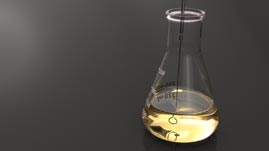Teachers' Domain - Digital Media for the Classroom and Professional Development
User: Preview

Source: Produced by WGBH and Digizyme, Inc.



In this animation produced by WGBH and Digizyme, Inc., learn how researchers expand exponentially a population of transformed bacterial cells using solid and liquid culture media. The animation explains the role of ampicillin (an antibiotic) and arabinose (a sugar), which are used for selection in the growth media. It also demonstrates how the transformed bacteria are separated from nontransformed bacteria.
Once bacteria have been successfully transformed—with a plasmid containing a gene that expresses a protein of interest—the next experimental goal is to isolate the transformed bacteria and then expand its population to obtain large quantities of the protein. Isolation of transformed bacteria is usually done in a solid culture medium like an agar plate, and expansion is usually done in a liquid medium like a broth. Researchers preparing a culture enhance selection for the transformed cells by using an antibiotic in the growth medium. Transformed cells carrying an antibiotic-resistant gene are able to grow with an antibiotic in their environment, while nontransformed cells are not. Thus, the antibiotic selects the cells transformed with the plasmid carrying the antibiotic-resistant gene.
In the lab animation, the culture plate and broth both contain the antibiotic ampicillin so that the culture will yield a larger share of cells containing the red fluorescent protein (rfp) gene of interest. A simple sugar called arabinose is also added to the culture medium in order to induce expression of the rfp gene, which in turn causes the transformed cells to appear reddish in color.
To expand the population of transformed cells for protein production, researchers take a small sample from an agar plate containing the transformed bacteria and transfer the cells into a flask containing LB (lysogeny broth) medium ampicillin, and arabinose. The transformed cells will divide exponentially, and, by the next day, the medium will be red and cloudy, indicating the presence of bacteria containing rfp that express red modified fluorescent protein (mFP). The contents of the flask are then put into centrifuge tubes and spun at high speed. When a tube containing a mixture of proteins or other particulate matter, such as bacterial cells, is rotated at high speeds, substances of greater density separate from those of lesser density. The denser particles move towards the bottom of the centrifuge tube, where they form a semisolid pellet. This pellet is enriched with transformed bacterial cells that contain mFP protein aggregates, also called inclusion bodies. The remaining medium above the cell pellet—called the supernatant—gets poured out of the tube.
The inclusion bodies containing the protein of interest can now be harvested from the cell pellet using a process called cell lysis. Lysis relies on a chemical solution that contains the enzyme lysozyme, which helps break down the membranes of the cell and inclusion bodies. After contents spill out of the cell into a buffer solution, the proteins can be separated from other cell products by another round of centrifugation.
 Loading Standards
Loading Standards